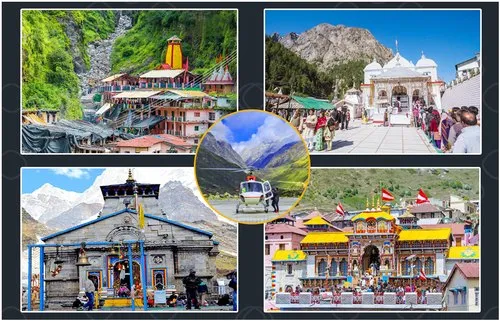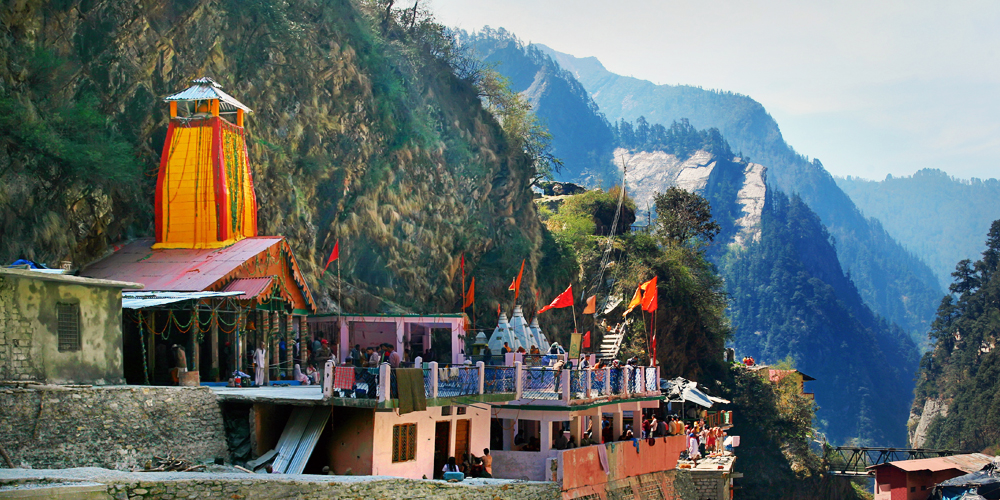Char Dhaam
Book Char Dham Tour Package by Ajeya Enterprises

The Char Dham Yatra is one of India’s most sacred pilgrimage journeys, covering the four holy shrines of Kedarnath, Badrinath, Gangotri, and Yamunotri in Uttarakhand’s Garhwal Himalayas. These shrines mark the spiritual origins of the Ganga, Yamuna, Alaknanda, and Mandakini rivers. Established as a sacred circuit by Adi Shankaracharya in the 8th century, this yatra attracts thousands of devotees each year between April and November.
When you book a Char Dham tour package by Ajeya Enterprises (powered by Trippin – India’s best travel agency), you get a well-planned itinerary, comfortable travel arrangements, and expert guidance to make your spiritual journey truly memorable.
Opening and closing dates of Chardham Yatra

The Char Dham temples open between April and May and close in October or early November, depending on weather and government notifications. In winter, the deities are moved to their winter abodes — Ukhimath (Kedarnath), Joshimath (Badrinath), Mukhba (Gangotri), and Kharsali (Yamunotri) — which remain open year-round.
Destinations Covered in Our Best Char Dham Tour Package

Kedarnath
Kedarnath lies close to the source of the Mandakini River, the Chorabari Glacier and is backed by the frosty Himalayan peaks. It is at an elevation of 11,755 foot with Gaurikund being the closest road-head to Kedarnath, being about 14 kilometre away. The stone hump worshiped inside the temple has a mythological connection that traces its roots in the epic Mahabharata where the Pandavas after defeating the Kauravas who were after all their own family members, sought mercy of Lord Shiva. But Shiva refused to forgive them, turning the Pandavas more resolute in their will to seek forgiveness. Shiva in order to evade them turned into a bull and came to earth. In his rush, he left his hump in Kedarnath, close enough to the Chorabari Glacier, a spot marked by an 8th century temple of Adi Shankaracharya. The other parts of the bull’s body are worshiped at the other four Panch Kedar shrines. The bull’s arms at Tunganath, navel at Madmaheshwar, face at Rudranath and hair at Kalpeshwar.
Significance of Kedarnath
The Kedarnath Temple has one of the most dramatic settings of Hindu temples owing to its location close to the Chorabari Glacier from which the Mandakini River originates. Kedarnath is also among the twelve Jyotirlingas, bringing Hindu pilgrims to it all through summer, marked by deep gorges, apple orchards, snow-capped peaks and terraced hill slopes. You can reach Kedarnath from Gaurikund, the closest road-head which is about 14 kilometre away. The trek goes uphill from Jangal Chatti, about 4 kilometre away, the Chhoti Linchuli and Badi Linchuli before crossing the Mandakini River and heading to the southern face of the Kedarnath peak.

Badrinath
Badrinath Temple too has a stunning setting at the base of the pyramid-shaped, snow-capped Nilkantha peak, dedicated to Lord Vishnu. Picturesquely located, it also happens to be one of Chardham’s most easily accessible temples founded by Guru Adi Shankaracharya in the 8th century. The temple though has been refurbished and renovated over a period of time. At the foot of the temple are hot springs whose waters reach a scathing 40 degree Celsius, serving as a laundry and bath house for the locals. Adi Shankaracharya who built the original Badrinath Temple had found the Badrinayaran idol in the Alakananda River. The temple as it stands today was built in the 16th century by the King of Garhwal complete with its elaborate carvings, stone embedding, columns, giving the temple the appearance of a Buddhist Vihara. Legend has it that Lord Shiva meditated on this spot for many years while Goddess Lakshmi offered shade to him in the form of a Badri tree, fetching the place its name. Even today, the surrounding Kedar-Badri valley is believed to be the home of Lord Shiva, a reason people slate their annual Chardham tour around Mahashivaratri when the festivities pump life and colour into the shrines.
Significance of Badrinath
A holy shrine for Vaishnavites, Badrinath is among the 108 Divya Desams incarnation of Vishnu. Aside from that Badrinath is also among the Panch Badri temples namely Yog Dhyan Badri, Adi Badri, Bhavishya Badri, Vriddha Badri and Badrinath temple. At an elevation of 11,204 foot in Uttarakhand’s Chamoli district, Badrinath is nestled in the quiet Garhwal valley, on the shores of the mighty Alaknanda. The Badrinath town is pristine and beautiful, peppered by thick forests, ample views of frosted mountain peaks and the holy river cutting through the green valley and flowing down it. Some prominent celebrations that take place in Badrinath include Kedar-Badri Utsav, Janmashtami and Mata Mruti ka Mela. Sights you can round up close to Badrinath include Badri Narayan Temple, Panch Prayag Temple, Tapt Kund for their hot water springs, Mana village, Bheem Pul, and Vasudhara Falls among others.

Gangotri
The Gangotri Temple is one of the holiest shrines in the country primarily for being a source of the most revered Hindu river, the Ganges. According to mythology, the rock on the site served as a cushion to save the earth from havoc the river could have caused as it poured out of Shiva’s matted locks in heaven. Lord Shiva is believed to have placed that rock strategically to take the onslaught of the gushing waters. The Gangotri Temple goes back to the 18th century when it was built by Amar Singh Thapa, a Gorkha commander. Though it is Gaumukh which is the foremost source of the Ganges, Gaumukh being a glacier about 19 kilometre further from the Gangotri Temple. Gangotri at an elevation of 10,170 foot lies on the banks of the Bhagirathi River, Ganga being called Bhagirathi till it reaches Devprayag, where Bhagirathi meets the Alakananda to form the Ganges. The Gangotri Temple opens on Akshay Tritiya, typically in May and shuts down on Bhai Duj, typically in late October or November. Harking back on Ganga’s healing and spiritual properties, pilgrims carry back bottles full of holy water from here. The Gangotri region has a rich biodiversity, being rich in several endemic species of flora and fauna. There are several smaller temples close to the main shrine, each reiterating Ganga’s evolution while tracing back its mythological roots.
Significance of Gangotri
Hindu mythology has it that Ganga was born out of a gift given by Lord Shiva to King Bhagirath for his tireless penance. But knowing the true power of the Ganges and the calamity it would unleash if allowed to flow down unbridled, Lord Shiva caught the river in his locks, making it flow down through it. The sacred stone which took the brunt of the gushing river lies close to the Gangotri shrine, marking the place where the river first landed on earth, one of the reasons Ganga is called Bhagirathi, after her father, King Bhagirath. During the construction of the temple by Amar Singh Thapa in the 18th century, the Gaumukh glacier, one of the sources of Ganga’s origin, was present at this very site. But over years, due to soil erosion and other environmental factors, the glacier receded to its present location.

Yamunotri
Among the Chardham pilgrimages, the Yamunotri Temple was built in the 19th century close to the source of the holy Yamuna River. The temple is about a 5 kilometre hike from a remote village called Janki Chatti. There are several hot springs around the temple which are fine for taking a dip in; you will also find pilgrims cooking potatoes and rice as prasad at the temple. You can organise your puja at a cost with the local priests at the temple. Yamunotri, the source of the Yamuna River is enclosed by forested peaks and a beautiful, sprawling valley. The second holiest river in the country after the Ganges too has a mythological connect. It is considered that a dip in the Yamuna, believed to be the daughter of Surya and sister of Yama, cleanses you of your sins. The high-point of Yamunotri, however, remains the hot springs around it where rice is cooked and made into prasad which is distributed among devotees at the temple. In and around the Yamunotri Temple are many shrines, temples and ashrams which you can look up too and take in the holy aura of one of Chardham’s most charming sites.
Significance of Yamunotri
Located at an altitude of 10,803 foot in the Garhwal Himalayas, Yamunotri is about 40 kilometre from Barkot in Uttarkashi. The actual source of Yamuna is in the Yamunotri Glacier which is at an elevation of 20,954 foot close to the Bandarpunch Peaks. Places you can explore on your Yamunotri trip include Divya Shila, Hanuman Chatti, Surya Kund and Saptarishi Kund Lake. The Yamunotri Temple is dedicated to goddess Yamuna who is depicted by a black marble idol in the temple. Though the original Yamunotri shrine was built by Maharaja Pratap Shah of Tehri Garhwal to the left shore of the river, the present structure came up in the 19th century and was commissioned by Maharani Gularia of Jaipur in the 19th century
Why Choose Ajeya Enterprises for Your Char Dham Yatra?
✅ Best Char Dham tour package with customizable itineraries
✅ Comfortable transport and accommodation arrangements
✅ Experienced guides and professional support
✅ Affordable pricing with no hidden costs
✅ Recognized as the best travel agency in Delhi NCR
Frequently Asked Questions (FAQs)
Q1. When is the best time to book a Char Dham tour package?
A: The ideal time is between May and June or September to October for pleasant weather and safer travel conditions.
Q2. How many days are required for Char Dham Yatra?
A: The standard tour duration is 10–12 days, but we also offer shorter or longer packages based on your preferences.
Q3. Is the Char Dham Yatra safe for senior citizens?
A: Yes, with proper planning, comfortable transportation, and assistance, senior citizens can undertake the journey safely.
Q4. Can I customize my Char Dham tour package?
A: Absolutely! Ajeya Enterprises offers tailor-made itineraries to suit your travel needs and schedule.
Q5. Which is the best travel agency for Char Dham Yatra?
A: Ajeya Enterprises is widely regarded as the best travel agency in Delhi NCR for Char Dham Yatra packages.

